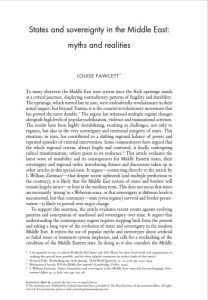Rejoignez getAbstract pour lire le résumé !

Rejoignez getAbstract pour lire le résumé !
Louise Fawcett
States and sovereignty in the Middle East: myths and realities
Chatham House, 2017
Aperçu
Despite predictions to the contrary, the Middle East state system remains remarkably resilient.
Recommendation
From the Arab Spring to the Syrian Civil War and the rise of ISIS, the Middle East has undergone tremendous upheaval in recent years, leading many experts to predict the imminent disintegration of the Middle East state system. However, as Oxford University political scientist Louise Fawcett argues in International Affairs, these predictions have so far failed to materialize. Fawcett challenges some of the international relations theories that have given rise to the myth that the Middle East’s artificially drawn borders are too weak to withstand the kind of internal and external challenges they have been fighting since 2011. getAbstract recommends her heavily footnoted paper to political scientists and anyone who wants to find out why the borders in the Middle East are not actually crumbling.
Summary
About the Author
Louise Fawcett is professor of international relations at St. Catherine’s College at Oxford University.
















Comment on this summary